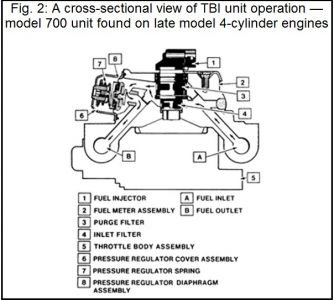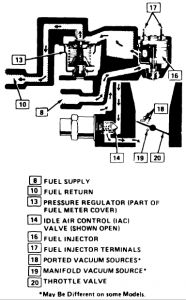Regulator-1994-97 I engines
1. Properly relieve the fuel system pressure and disconnect the negative battery cable.
2. Remove the fuel return pipe from the regulator and discard the old O-ring.
3. Disconnect the vacuum hose from the regulator.
4. Remove the fuel return pipe clamp.
5. Remove the pressure regulator attaching screw, then remove the regulator and discard the O-ring.
Use a wrench to unfasten the fuel line-to-regulator fitting
Disconnect the vacuum hose from the regulator
Remove the pressure regulator attaching screw
Remove the regulator from the manifold and discard the O-ring
To install:
6. If the old pressure regulator is being installed, check the filter screen (if equipped) for contamination and replace, if necessary.
7. Lubricate the new O-rings with clean engine oil, then install them on the pressure regulator and fuel pipe.
8. Install the pressure regulator onto the manifold.
9. Make sure the regulator attaching screw threads are covered with Loctite � 262 or an equivalent threadlocking compound, then install and tighten the screws to 31 inch lbs. (3.5 Nm).
10. Connect the vacuum hose to the regulator.
11. Make sure the new O-ring is in position, then connect the fuel return pipe to the pressure regulator and tighten to 22 ft. Lbs. (30 Nm).
12. Install the fuel return pipe clamp and attaching nut to the lower intake manifold assembly.
13. Connect the negative battery cable, then pressurize the fuel system by cycling the ignition (without attempting to start the engine) and check for leaks.
Thursday, April 11th, 2019 AT 6:05 PM
(Merged)




